How to Test a Motorcycle Battery with a Multimeter (Guide)
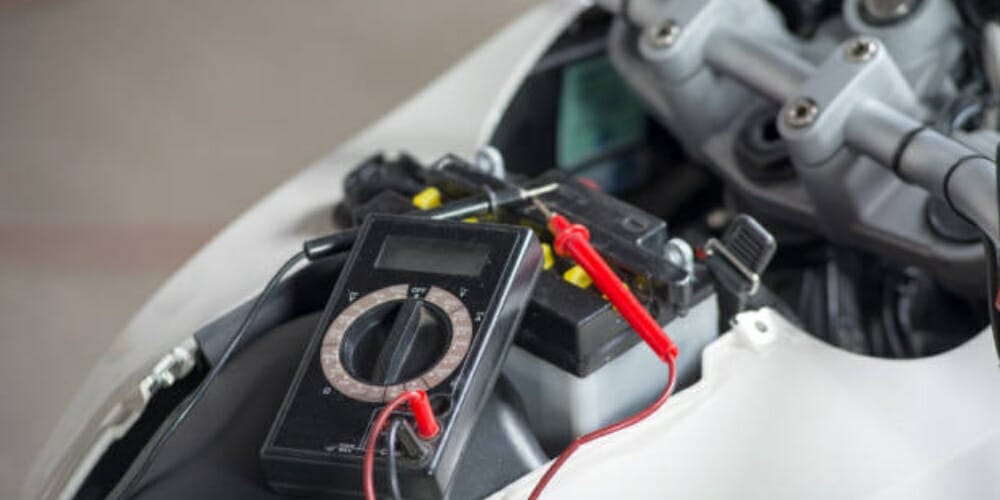
The heartbeat of a motorcycle is in its battery. If the battery is dead, it becomes impossible to move the motorcycle from where it is. You expect the engine of your motorcycle to come to life whenever you start it. The battery is what delivers the power that gives life to the engine.
That means without battery power, you cannot ride. So, how can you avoid this? It is simpler than you think! You can test your motorcycle battery. This should be a part of your routine maintenance schedule. One other benefit of checking and testing the battery is that it ensures the longevity of your bike.
You can test your motorcycle battery with a multimeter in three easy steps mentioned below:
- Take safety precautions.
- Perform initial testing.
- Perform load testing.
Understanding the Technical Specifications of the Original Battery of your Motorcycle.
When compared to car batteries, motorcycle batteries require more maintenance. The reason for this is simple. Batteries are lead-acid batteries. They go through a normal discharging process if they are not charged. To ensure the optimal function of your motorcycle battery, you should understand its technical specifications. (1)
There are two kinds of battery cells. They are Primary Cells and Secondary Cells. Primary Cells are disposable batteries and not rechargeable while Secondary Cells are rechargeable. There are different brands of motorcycle batteries in the market. You can easily change your motorcycle battery when it goes bad.
However, it is recommended that you maintain your original battery to extend its lifespan. This will save you the stress of having to buy a new one ahead of its end of life. In this post, we will show you how to test a motorcycle battery with a multimeter. Let’s dive right in!
Three Steps to a Test Motorcycle Battery
So, you are ready for your routine maintenance check? The first thing is to test the motorcycle battery. How do you go about it?
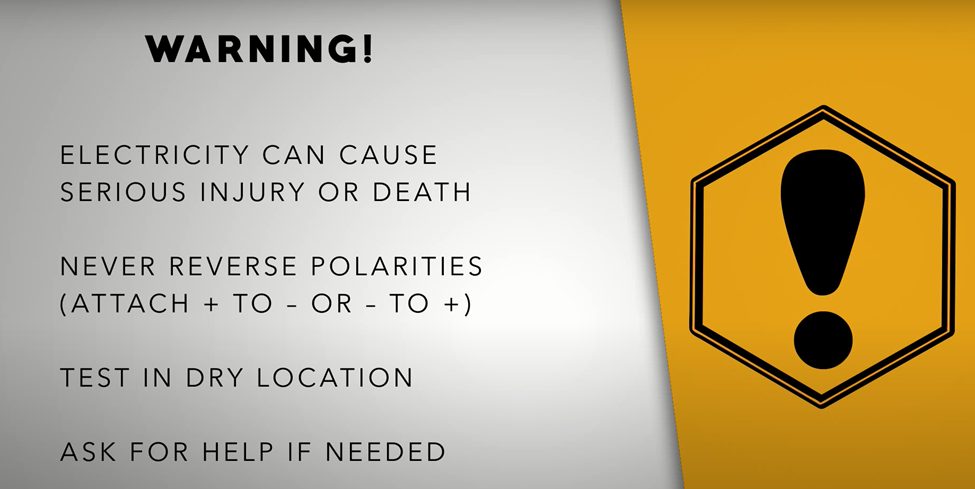
Step 1: Take Safety Precautions
The first step to test a battery is to check the basics and perform safety procedures. As you may already know, motorcycle batteries contain lead-acid. This is highly flammable. Therefore, you need to be extra careful all through the testing process. We recommend that you work in a well-ventilated area.
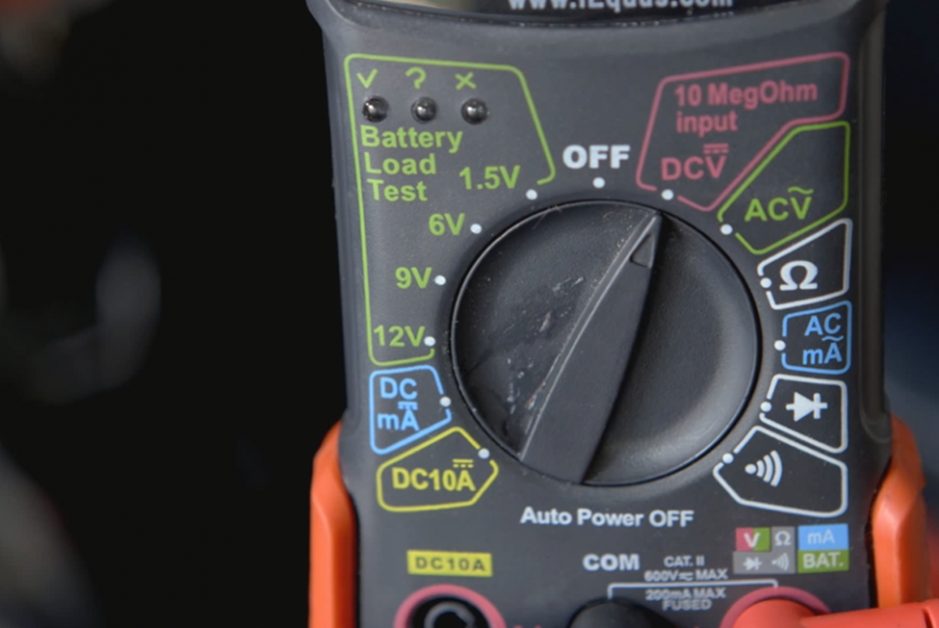
Keep sources of sparks or open flames far away from the battery. Check for any cracks or corroded terminals. You should also check for any leaks around the battery. We also recommend that you have your protective gear, such as gloves and eye protection.
Step 2: Initial Testing
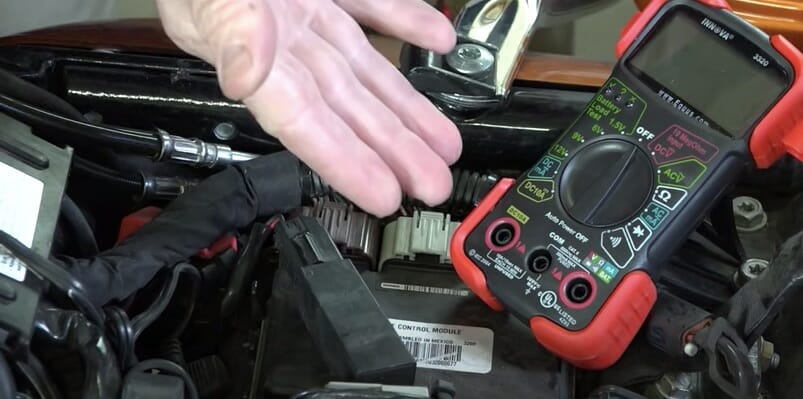
The next step is to perform the preliminary voltage test. You need a digital voltmeter to complete this stage. You also need some gear, such as safety glasses, latex gloves, and hand tools. These are needed to disconnect and remove side covers or a saddle. With this, you can gain access to the battery.
Before a battery load test, you should start with a static test. This is to verify if the battery is charged fully or not. There are two ways to do this. You can take a ride and ignite the charging system or use a charger. You should let the battery cool for a minimum of one hour before you perform the test.
Here are important things to note when turning off your motorcycle:
- Regulate the voltmeter to DC scale for 0-24
- Connect a positive meter lead to the associated positive terminal on the motorcycle battery.
- Repeat the process for the negative meter lead and connect it to the negative terminal
- Connect the negative meter lead to the terminal of the negative battery
- Check the reading and record the voltage test.
If the reading is 12VDC or below, it means the battery is not fully charged. You should recharge it before you proceed. After charging, let the battery rest for another one hour or so and perform the test again. A fully charged and rested battery that tests between 12 and 12.6VDC may start the motorcycle.
Step 3: Load Testing
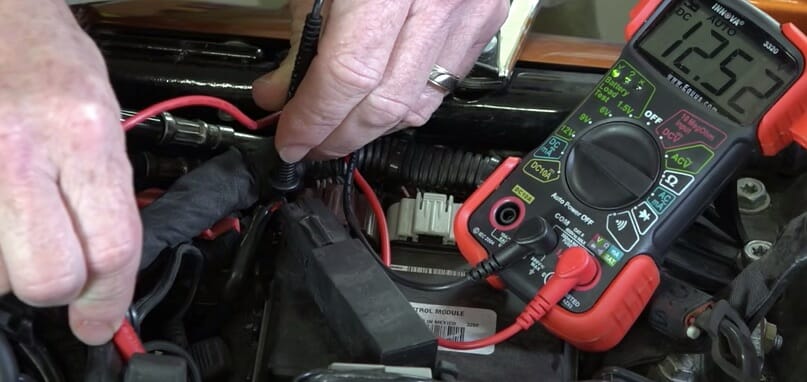
What does battery load testing mean? It is the reading of the voltage at the terminal of the battery. This is done when the motorcycle is switched on and pulling power from the battery. It is worth mentioning that the point of maximum demand on the battery is during startup. You need a battery load tester to perform this test.
What does the process involve? It involves observing your battery to establish the percentage it is charged and the level of charge it needs to be fully charged. Although there are unconventional methods to test motorcycle battery load, it is recommended that you use a temperature-compensated hydrometer or a digital voltmeter.
During the load testing, here are the steps you should take:
- Put your motorcycle in a steady position in an open and well-ventilated area. Make sure that the transmission is put on neutral.
- Place the voltmeter in a way that will let you read it when you start the motorcycle.
- Start the motorcycle and simultaneously check the voltage. If the battery and the charging system are both in perfect condition, the voltage test should show 10 to 11 volts when the engine spurs to life.
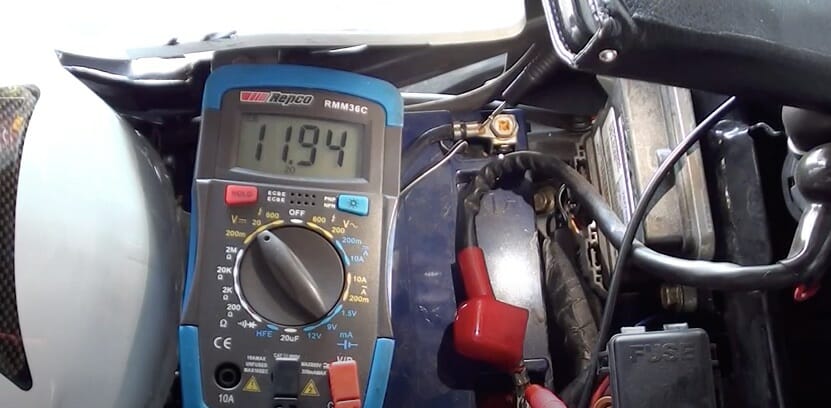
- If the voltage drops low to 9.5 volts or below when the engine starts, it means at least one of the cells of the battery is bad. You should replace it immediately so it does not cause havoc on the rest of the components of the battery.
Wrapping Up
The battery is the life of a motorcycle. If your bike does not have a good battery, you cannot drive anywhere, no matter how powerful engine is. That is why it is highly recommended that you regularly test the motorcycle battery to know the state.
If you think your battery is bad, you should not ride your bike until you get a professional to have a look at it or replace it. The guidelines highlighted above provide solutions to how to test a motorcycle battery with a multimeter. You should make this a part of your preventive maintenance routine.
Take a look at some of our related articles below.
- Multimeter setting for car battery
- Multimeter 12v battery test
- How to test car battery with multimeter
References
(1) motorcycle – https://www.gearpatrol.com/cars/motorcycles/
a488757/types-of-motorcycles/
(2) powerful engine – https://www.zmescience.com/science/biggest-most-poweful-engine-world/
Video References
Ryan Urlacher
HowToNick
